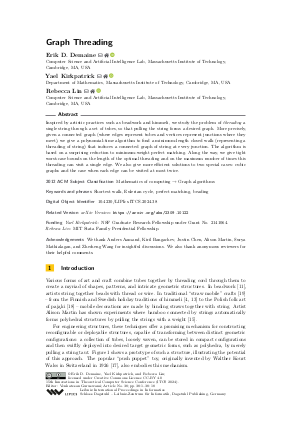@InProceedings{demaine_et_al:LIPIcs.ITCS.2024.38,
author = {Demaine, Erik D. and Kirkpatrick, Yael and Lin, Rebecca},
title = {{Graph Threading}},
booktitle = {15th Innovations in Theoretical Computer Science Conference (ITCS 2024)},
pages = {38:1--38:18},
series = {Leibniz International Proceedings in Informatics (LIPIcs)},
ISBN = {978-3-95977-309-6},
ISSN = {1868-8969},
year = {2024},
volume = {287},
editor = {Guruswami, Venkatesan},
publisher = {Schloss Dagstuhl -- Leibniz-Zentrum f{\"u}r Informatik},
address = {Dagstuhl, Germany},
URL = {https://drops.dagstuhl.de/entities/document/10.4230/LIPIcs.ITCS.2024.38},
URN = {urn:nbn:de:0030-drops-195665},
doi = {10.4230/LIPIcs.ITCS.2024.38},
annote = {Keywords: Shortest walk, Eulerian cycle, perfect matching, beading}
}

 Creative Commons Attribution 4.0 International license
Creative Commons Attribution 4.0 International license





